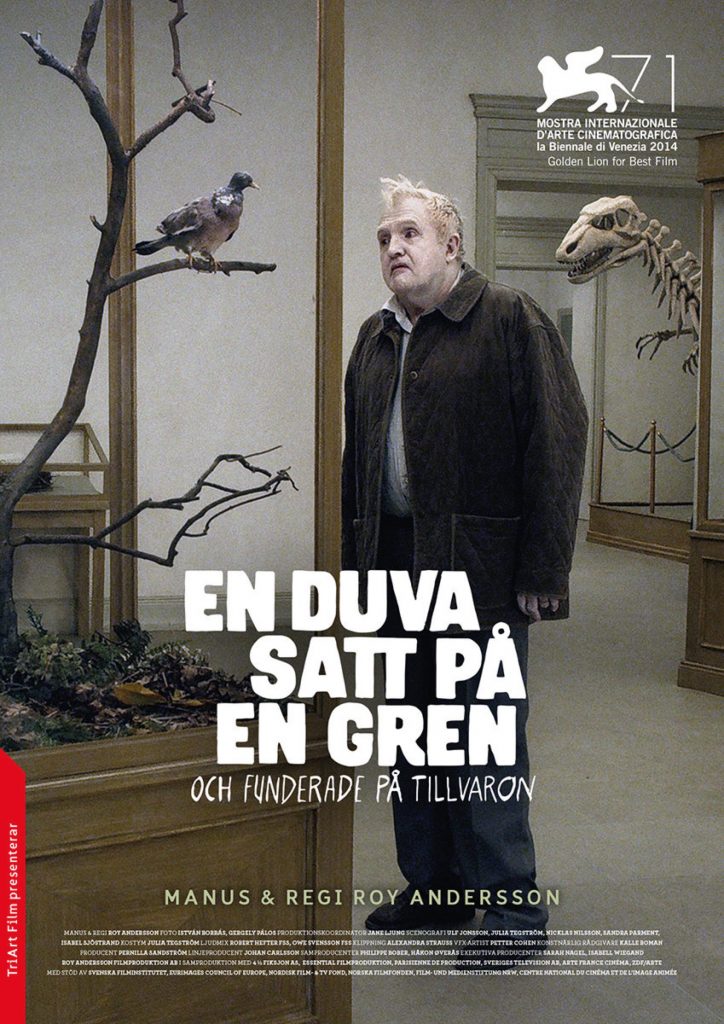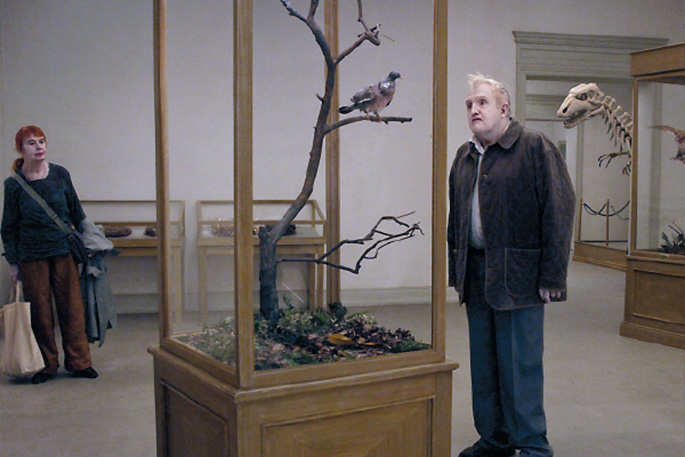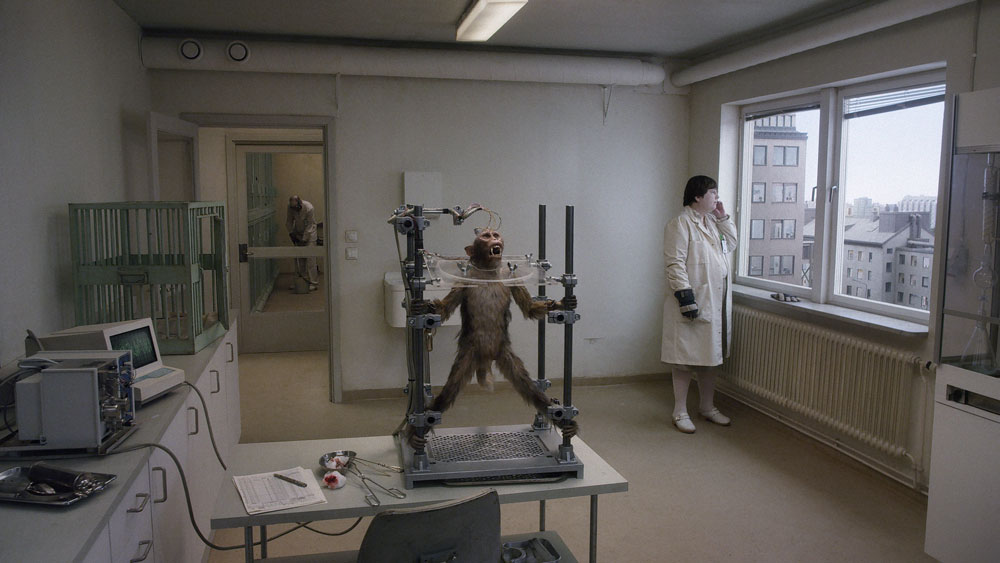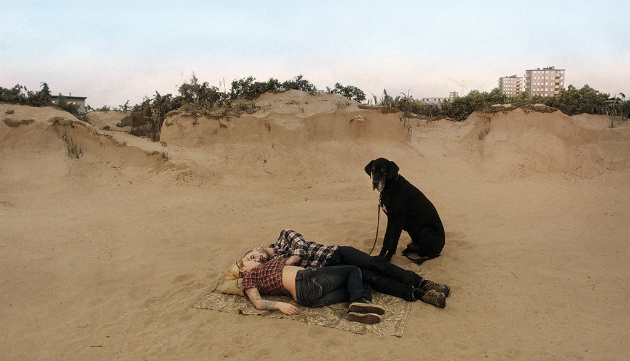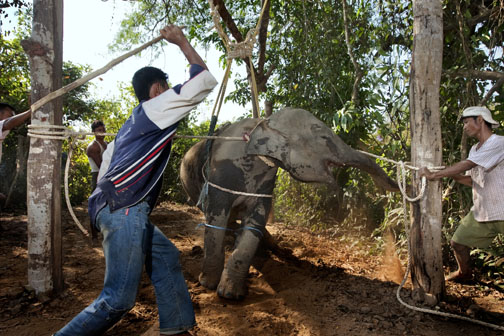A man dies whilst trying to open a bottle of wine. Shots of aquavit are handed out in a bar in exchange for kisses. A young couple lie together on a beach, accompanied by a dog. The owner of a delicatessen addresses the camera from the steps to his shop as his co-worker ridicules him from inside.
These short, unrelated stories capture Roy Andersson’s 2014 film A Pigeon Sat on a Branch Reflecting on Existence perfectly.
A long title has become synonymous with Swedish literature, and Andersson’s A Pigeon… is no exception. A far cry from the action of Steig Larsson’s Millennium trilogy, we are shown a series of tableaux episodes which appear disjointed and unconnected. In fact, to attempt to describe the film is, in a way, doing it a disservice [1]. The only recurring characters are two travelling salesmen, Sam and Jonathan, who we loosely follow as they attempt to sell novelty products. As Andersson constructs his world of grey walls and uninterested expressions, we are shown a persistent exploration of our meaningless existence through the eyes of a stuffed bird.
Andersson’s unique film-making, ironically, does not allow the film to be easily ‘pigeon-holed’. However, A Pigeon… is most readily a black comedy. The majority of his filmography equally share this appreciation for subtleness within a bland world, with bright colours, emotions and expression being kept to a minimum, representing a realism that is primarily concerned with the grotesque facets of macabre and the emptiness of life. However his film’s prop up such strangeness with brief moments of relief that, whilst sticking to his signature style, celebrate the joys of life, however infrequent they may be. In regards to A Pigeon…, as the title suggests, the viewer becomes the pigeon looking out upon humanity and reflecting, questioning what is it to be human. The film explores the complexities of a human-animal relationship through zoomorphism, discussed below, and Andersson’s camera work; his preference for a static camera confirms that we are the motionless bird. By constricting us to this claustrophobic view he emphasises the need to not look away from the facets of life, awarding us an anchored view of the moments of pleasure in comedy and, consistent to his style, a unhesitant gaze upon that which is more troubling. The choice of a stuffed bird reflects Rachel Poliquin’s exploration of taxidermy in her cleverly named book, The Breathless Zoo. Poliquin examines the longing attached to taxidermy, discussing the double-edged nature of the process, as the animal becomes both something symbolic and individual. She asks, “what can any piece of taxidermy offer?” [2]. Andersson’s film seeks to answer this question, suggesting that we can view our own humanity through the eyes of the subjected animal. However, this constructs a circularity that in turn perpetually critiques the human. In order to assess our own humanity for what it is, we must first assert a dominance over the animal in order to gain such an insight, being the killing and stuffing of a bird in this case. it is only through a fault that the human is finally aware of the fault itself.
Before the long title drags itself across the screen we observe a washed-out figure navigate a museum display hall, gazing upon the stuffed animals. The film explores the human, so to open with the human intrigue into the animal constructs the underpinning notion that we reflect upon our humanity by reflecting upon what we are not. The character’s sustained staring at the pigeon demonstrates this intrigue, reinforcing the idea that we construct ourselves in relation to the other. His wife stands by, blending into Andersson’s colourless scene, and therefore, into a mundane and everyday existence as she ignores the animal. The mise-en-scene acts to mirror the animal and human, placing them either side of the glass, whilst similarly demonstrating the arrogance which encompasses humanity. The human’s abuse of the animal for a selfish intrigue is demonstrated, with an animal reaction manifested in the other stuffed (and skeletal) figures placed in the background in the pose of an attack. This exceptionalism of the human, being a belief in that the human is both different and greater than the animal, lies at the foundation of Andersson’s reflections upon humanity. As suggested above as a response to the act of taxidermy itself, this idea is that the human is a supreme being upon Earth, providing justification to the subjection of the animal. It is this exceptionalism that is unequivocally condemned, which Andersson presents to us through a zoomorphic lens.
Zoomorphism can be described as the ascribing of the animal to the human, a reversal of anthropomorphism. Rather than simply imposing animal characteristics, the film locates the human viewer as the animal, becoming a being that is completely autonomous of humanity. We, the viewer, become the animal staring back out from the glass display box. This animalisation of the viewer allows for a richer exploration of what it is to be human; Andersson constructs his film to say that through viewing his scenes as an animal, we can reflect upon humanity. It is only through what we are not that we can understand our human identity, so by animalising the viewer into the stationary bird, we are given a dogged look at the human. The ironic notion of ‘thinking outside the box’ is intrinsic to break away from our unsatisfactory humanity.
As the film’s 100 minute lifespan begins to dwindle Andersson gives us a section entitled ‘homo sapiens’, an unflinching look at the making of the modern human. The ubiquitous static camera introduces a laboratory lacking in colour, this drabness being coined ‘greige’ [3]. A female doctor gazes out of the right of the frame. Centrally, a monkey is pinned within a metal structure. Whilst animatronic for the purpose of the film, the blooded tissue alongside underpin the notion that the film presents this as a real monkey. The style of anderson’s work draws attention to such a small object within the wider frame; a lack of colour in the mise-en-scene brings the redness of the blood to the fore. As the scene plays out, the monkey is electrocuted and the doctor’s indifference to its cries highlight not just the obvious cruelty of animal testing, but more pressingly, a human need to be ignorant to the disagreeable conventions of our existence. The space between both figures speaks to how removed the human is from nature, and the mobile phone is a figment for our corrupted humanity, diverting attention away from the injustice occurring before us and onto something absent. As a result of his camerawork, Andersson forces his commentary through an unhesitating view upon that which we do not want to see. The perpetuity of animal abuse, as depicted in this scene, is echoed in the following horrific sketch. We are shown a group of slaves being led into a metal drum by colonial soldiers, which is subsequently set on fire. Their screams become music played out through its pipes. A 180 degree reversal of his static camera reveals a dinner party watches on. The paralleled imagery of the subjection of the animal, being both the obvious (the monkey) and the metaphorical (the slaves), highlights humanity’s dependency upon its horrific past in its claim to supremacy. This “logic of domination” is something which Jennifer Ladino refers to in discussing the human justification of a dominance over what is not human, by ascribing ‘animalistic’ tendencies to themselves, a zoomorphic act [4]. However, the animalism which the human uses to justify their existence is in itself not animal, but a human fabrication and manipulation of the animal.
However, just as the animal torture depicts the blindness of humanity, a scene located upon a beach offers us a more positive representation of the delicate relation between animal and human. The suggestion of a mutually shared individualism is made, whilst remaining within the sphere of companionship. As the young couple lie on the beach, a dog sits by. This everyday scene locates the oppressive human buildings in the distance, highlighting the separation of this image to that of the monkey. Anat Pick states that the screen “transforms all living beings – including humans – into creatures”, an ideology which A Pigeon…subscribes to [5]. Equality breeds tranquility in certain scenes, and an asserted superiority condemns the human in others. As averse to the laboratory scene, here we are happy for the lack of camera movement; the single frame holds both human and animal together in a simple, yet harmonious partnership. A similar scene of simplistic companionship shows a women and a baby on a park bench, the baby representing the animal in its lack of human experience, and therefore a failure to appreciate humanity’s claim to supremacy. Again, Andersson’s camerawork is at play, as his middle-distance shots do not reveal personas, meaning expression is lost and we return to the suggestion that whatever is on screen is an equal creature [6].
The films poses our human exceptionalism as being rooted in a self-conscious blindness to that which is disagreeable, such as animal testing, but fundamental to this supremacy. However, Andersson attempts to destabilise this hierarchical make-up of the world in the eyes of the human through the zoomorphism of the viewer and his depiction of animal testing. Similarly, his presentation of harmony brings about a contrast, posing an alternative for the viewer. It is no surprise that this beach scene is one of the most colourful in the film, as the human both accepts and moves beyond their subjection of that which is not human. Andersson demonstrates our reliance upon the animal to manufacture what it is to be human, and in turn reflect upon this. In doing so, he asks us how can we be greater than that which constructs us?
The message Andersson highlights is one which is being seen in an ever greater number of socially-aware documentaries in contemporary cinema. Whilst the style of documentary filming is worlds away from A Pigeon…’s macabre world, the same ideology rings through of humanity’s abuse of its perceived power. He poses human exceptionalism as the basis of our flawed being, showing the need to break away from society’s assertive dogma, whilst films such as Black Fish (2013) and Earthlings (2005) convey a similar message but through a more obvious medium. These documentaries reveal the injustices that constitute the make-up our daily life, highlighting the human’s tendency to turn away from that which it finds troubling.
No more are the injustices suffered by the animal in wider culture clearer than within tourism. In a lack of mainstream education upon the subject, the human has created a paradox. We assert our supremacy over the animal due to our ability to reason, and therefore locate ourselves as educated. Yet there is a reluctancy to educate ourselves upon that which subjugates the animal and holds us within this position of power, in turn destabilising our dominion and removing educational supremacy. For example, elephants are subject to the ‘breaking of the spirit’ in order for tourists to ride them. This is ‘ignored’ by many in order for the activity to continue. If the ability to reason is inherently human, the choice to not reason is equally so, and a demonstration of our miseducation. We fabricate a narrative of the ‘happiness’ of the elephant whilst perched upon its back, just as Andersson’s film depicts the blindness to torture within a lab, for humanly gain.
The film acts to address the underlying problems of society and the humanity which we hold dear. His critique is not of the human exactly, but more so of the basis of our asserted exceptionalism which hold us suspended within a perpetually morbid life. It is only by stepping outside of human existence that we can see such wrongs, and in turn attempt to correct these.
[1] Amy Anna, A Pigeon Sat on a Branch Reflecting on Existence (2015) http://www.cutprintfilm.com/reviews/a-pigeon-sat-on-a-branch-reflecting-on-existence/ [accessed 19 November 2015].
[2] Rachel Polquin, The Breathless Zoo (Pennsylvania: Pennsylvania University Press, 2012), p.7.
[3] Amy Anna, A Pigeon Sat on a Branch Reflecting on Existence (2015) http://www.cutprintfilm.com/reviews/a-pigeon-sat-on-a-branch-reflecting-on-existence/ [accessed 19 November 2015].
[4] Jennifer Ladino, ‘Working with Animals: Regarding Companion Species in Documentary Film’, in Ecocinema Theory and Practice(London: Routledge, 2013), p. 133.
[5] Anat Pick, Creaturely Politics (New York: Columbia University Press, 2011), p. 106.
[6] Jason Anderson, A Pigeon Sat on a Branch Reflecting on Existence (Roy Andersson, Sweden) (2015) http://cinema-scope.com/spotlight/pigeon-sat-branch-reflecting-existence/ [accessed 23 November 2015].
Bibliography
Primary Text
A Pigeon Sat on a Branch Reflecting on Existence. Dir. Roy Andersson. Artificial Eye, 2015.
Secondary Texts
Anna, Amy, A Pigeon Sat on a Branch Reflecting on Existence (2015) http://www.cutprintfilm.com/reviews/a-pigeon-sat-on-a-branch-reflecting-on-existence/ [accessed 19 November 2015]
Anderson, Jason, A Pigeon Sat on a Branch Reflecting on Existence (2015) http://cinema-scope.com/spotlight/pigeon-sat-branch-reflecting-existence/ [accessed 23 November 2015]
Ladino, Jennifer, ‘Working with Animals: Regarding Companion Species in Documentary Film’, in Ecocinema Theory and Practice(London: Routledge, 2013)
Pick, Anat, Creaturely Politics (New York: Columbia University Press, 2011)
Poliquin, Rachel, The Breathless Zoo (Pennsylvania: Pennsylvania University Press, 2012)
Further Reading
Abrams, Simon, A PIGEON SAT ON A BRANCH REFLECTING ON EXISTENCE (2015) http://www.rogerebert.com/reviews/a-pigeon-sat-on-a-branch-reflecting-on-existence-2015
Christian, Paul, The Barbaric Tradition of ‘Breaking the Spirit’ of Elephants for Their Use in the Tourism Industry (2015) http://www.onegreenplanet.org/animalsandnature/breaking-the-spirit-of-elephants-for-use-in-the-tourism-industry/
Parr, Aaron, Mapping Contemporary Cinema: Short Guide to Zoomorphism (2015) http://www.mcc.sllf.qmul.ac.uk/?p=1528
Images
[2] http://gorillafilmonline.com/wp-content/uploads/2015/04/A-Pigeon-Sat-On-A-Branch-2.jpg
[3] http://twitchfilm.com/assets/2015/06/MagnoliaPictures_APigeonSatOnABranch-630.jpg
[4] http://thetravelmanuel.com/wp-content/uploads/2013/01/Photo1.jpg
